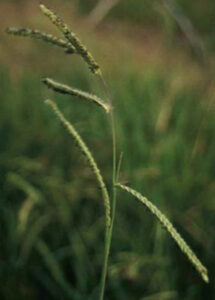Life cycle: Paspalum is a perennial, summer-active weed that is dormant in winter. It flowers from October to April. Seeds germinate in moist warm months. Seedling growth is slow, often taking two to three years to reach their first flowering.
As a soil indicator: Paspalum is more abundant on alluvial soils near streams and on claypans.
Beneficial attributes: Paspalum is a grazing-tolerant fodder plant that produces a good quantity of high quality, palatable forage.
Negative attributes: The dense growth habit of this week smothers most plants and seeds can block irrigation equipment.
Dispersal: Paspalum is spread by seed and rhizomes. Mature plants can produce more than 250,000 seeds. Seeds are dispersed by water, stock, and clothing. Rhizomes moved in soil will re-sprout.
Legislation: None
Non-chemical control methods: Clean clothing and prevent animals moving through infested areas when ripe seed is present, as it adheres to fur and material. Clean mowers and machinery before leaving infested areas.
Graze heavy in autumn and again in late winter to spring, with stock being removed when the annual grasses start to elongate in spring. When the heads of annual grasses just start to emerge, spray with an organic herbicide such as Slasher ® or mow regularly to reduce seed set.
Swards can be mown with a catcher before flowering to reduce seed banks.

Figure 1. Paspalum (courtesy of HerbiGuide http://www.herbiguide.com.au)
Resources
HerbiGuide (HerbiGuide website)
Henschke Wines: A non-chemical weed control case study from the Adelaide Hills, SA
Contact
For further information, please contact:
AWRI helpdesk
Phone 08 8313 6600 Email helpdesk@awri.com.au

